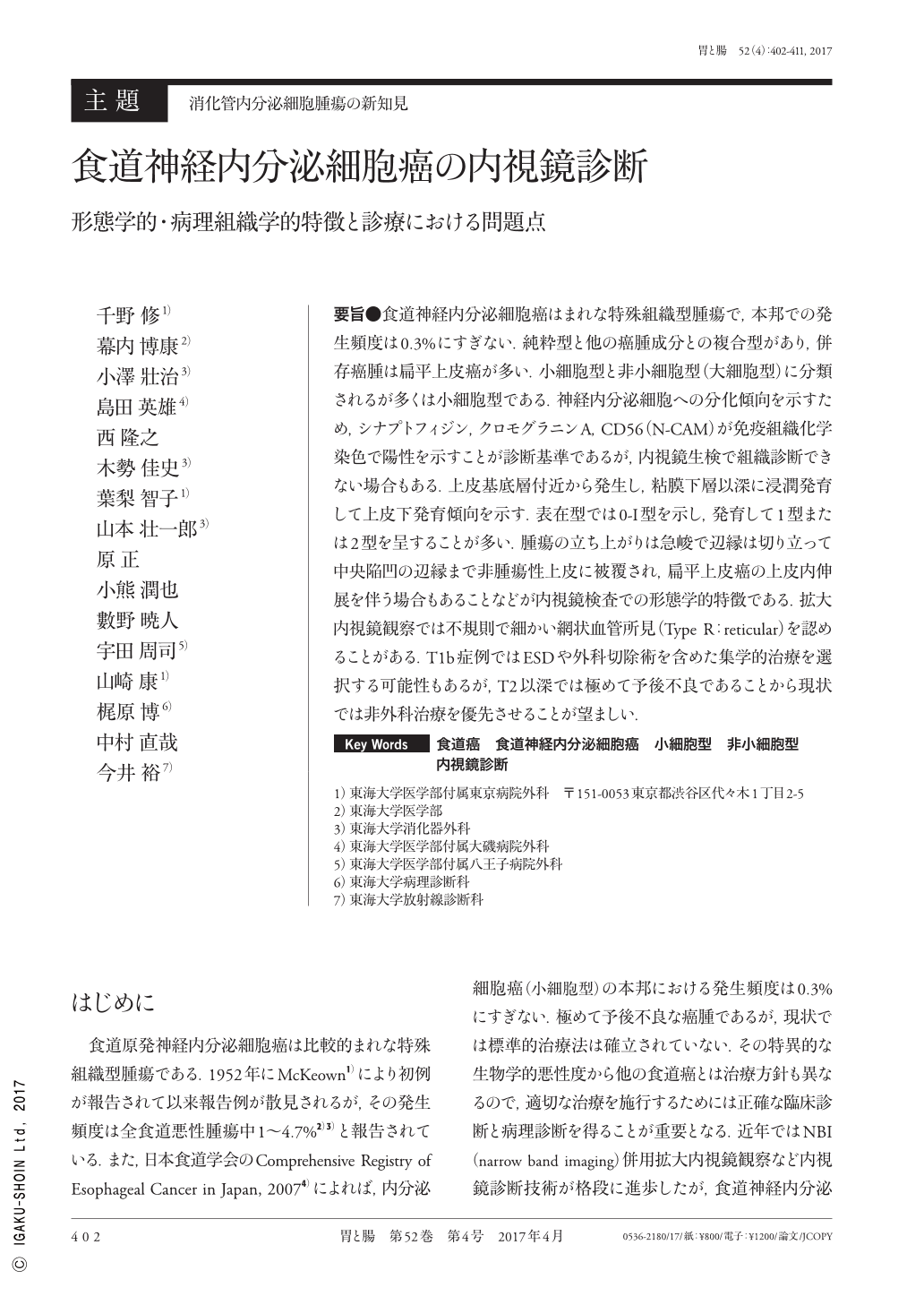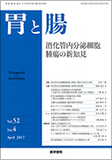Japanese
English
- 有料閲覧
- Abstract 文献概要
- 1ページ目 Look Inside
- 参考文献 Reference
- サイト内被引用 Cited by
要旨●食道神経内分泌細胞癌はまれな特殊組織型腫瘍で,本邦での発生頻度は0.3%にすぎない.純粋型と他の癌腫成分との複合型があり,併存癌腫は扁平上皮癌が多い.小細胞型と非小細胞型(大細胞型)に分類されるが多くは小細胞型である.神経内分泌細胞への分化傾向を示すため,シナプトフィジン,クロモグラニンA,CD56(N-CAM)が免疫組織化学染色で陽性を示すことが診断基準であるが,内視鏡生検で組織診断できない場合もある.上皮基底層付近から発生し,粘膜下層以深に浸潤発育して上皮下発育傾向を示す.表在型では0-I型を示し,発育して1型または2型を呈することが多い.腫瘍の立ち上がりは急峻で辺縁は切り立って中央陥凹の辺縁まで非腫瘍性上皮に被覆され,扁平上皮癌の上皮内伸展を伴う場合もあることなどが内視鏡検査での形態学的特徴である.拡大内視鏡観察では不規則で細かい網状血管所見(Type R:reticular)を認めることがある.T1b症例ではESDや外科切除術を含めた集学的治療を選択する可能性もあるが,T2以深では極めて予後不良であることから現状では非外科治療を優先させることが望ましい.
Neuroendocrine cell carcinoma of the esophagus is very rare, accounting for only 0.3% of the esophageal malignant tumors in Japan. This tumor is histopathologically subdivided into a pure or combined type. The combined type frequently includes the combination of this tumor with squamous cell carcinoma. This tumor is also subdivided into small cell and non-small cell(large cell)types, and the majority of reported cases were of small cell type. Its diagnosis is confirmed by immunohistochemical positivity for synaptophysin, chromogranin A, and CD56(N-CAM)staining, indicating neuroendocrine differentiation. An accurate diagnosis is occasionally possible only by a subtle biopsy specimen obtained by endoscopy. The neuroendocrine cell carcinoma of the esophagus develops in the primitive basal cells of the esophageal epithelium and invades beyond the submucosal layer with a subepithelial growth. Conventional endoscopy usually reveals type 0-I as superficial carcinoma and type 1 or 2 as advanced carcinoma. The edge of the tumor is sharply elevated, and most of the surface is covered with non-neoplastic squamous epithelium surrounding the central crater but is occasionally combed with the intraepithelial spread of squamous cell carcinoma. The microvascular pattern observed by magnified endoscopy frequently demonstrates irregular fine reticular blood vessels(Type R ; reticular). The prognosis of primary neuroendocrine cell carcinoma of the esophagus is very poor. Because of its highly malignant behavior, non-surgical treatment should be performed ; however tumor resection with ESD or surgery might be selected only in T1b cases.

Copyright © 2017, Igaku-Shoin Ltd. All rights reserved.


